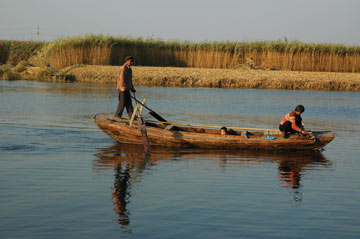|
NEWS NOTES
Algae eat up mercury in Chinese lake
| The fishing industry in Lake Baiyangdian, China’s largest natural lake, has suffered from pollution and drought. |
China’s largest natural lake, Lake Baiyangdian, is an important source of fish and water to nearby residents, but it is also polluted by sewage from agriculture and by industrial waste from factories in nearby Baoding City. New research shows that contaminants like mercury and arsenic are at dangerously high levels in the lake — but also suggests that this effect is mitigated in some places by algal blooms resulting from nutrient pollution. That complex interplay between different pollution effects may give landscape, fisheries and wildlife managers new insight into how these metals circulate through other contaminated ecosystems, both in China and globally.
Lake Baiyangdian, the largest wetland ecosystem in northern China, is an important source of fish and drinking water to nearby villages and to the city of Baoding, with a population of about 635,000. Nine rivers feed the lake, which is often called the “kidney” of northern China for its historical role in filtering the waters that flow through it. The lake is also a poster child for the widespread environmental impacts of the rapid growth of China’s economy, however. Droughts and dams upstream have shrunk the lake’s size, and increasing inputs of industrial waste, agricultural runoff and sewage into the lake over the past 50 years have polluted its waters and exacerbated a water crisis in the region, says Celia Chen, an ecotoxicologist at Dartmouth College in Hanover, N.H.
Although this case is extreme, similar problems of pollution and eutrophication — a surplus of nutrients leading to excessive plant growth — exist in many freshwater systems, including many other lakes in China, Chen says. Toxic heavy metals from industrial waste, such as mercury and arsenic, bioaccumulate as they move through the food web, from water to algae to zooplankton to fish, and ultimately, to humans, creating serious human health problems, she says.
Chen’s earlier work at a freshwater lake in Massachusetts suggested an interesting wrinkle to how the ecosystem responds to pollution, however. Nutrient enrichment from agricultural runoff and sewage into lake ecosystems can produce large seasonal increases in algae, called algal blooms. And more algae, she found, also scavenge more of the arsenic and mercury in the water.
“Algal blooms tend to ‘biodilute’ the metal, so that each microgram of algae has a lower concentration” of metal, Chen says. As a result, she says, the zooplankton that munch on those algae “consume food that has less metal per bite.”
Chen and her colleagues wanted to determine how mercury and arsenic are circulating through the food web in the highly polluted Lake Baiyangdian ecosystem. Both metals have potential human health impacts: Atmospheric emissions of mercury from coal combustion — China is the world’s largest consumer of coal — are deposited both regionally and locally. Arsenic is also a problem, entering the water through both geologic and anthropogenic sources.
The team looked at three locations within the lake, at different distances from sources of pollutants, including coal emissions, sewage and agricultural runoff. Studying metal concentrations in water, zooplankton and fish, the researchers found that the site that was closest to both industrial and nutrient pollution sources still had the lowest mercury and arsenic concentrations in the water — and it also had the most algae. The zooplankton and fish from the nutrient-enriched area also had lower mercury concentrations, which suggests that the algae are indeed affecting mercury’s transfer through the food web, the researchers wrote in an article published online Dec. 24 in Water, Air and Soil Pollution. As for arsenic, the algae decreased arsenic concentrations in the water, but didn’t appear to have the same effect on the metal in zooplankton and fish. That might be because arsenic moves somewhat differently through the food web than mercury does, the authors say.
That doesn’t mean that nutrient-induced algal blooms have saved the day, however. The fish used in the study were obtained from fishermen, and intended for market, the researchers wrote, but the concentrations of both metals in the fish were still dangerous if consumed by humans. In particular, mercury concentrations in the fish were higher than the threshold that the U.S. Environmental Protection Agency has determined poses a threat to humans and wildlife.
More monitoring of these metals is needed, Chen says. “I am hoping that in this period when China is becoming extremely aware of its environmental problems, that more monitoring will be conducted of these contaminants, particularly in fish that humans consume,” she says.
By showing how such an ecosystem might respond to changes in metal and nutrient inputs, the study “helps [managers] understand where to look and what to worry about,” says David Evers, executive director of the BioDiversity Research Institute in Gorham, Maine. “It really is a global issue,” says Evers, who was not involved in the study. With the rapid increase in the number of coal-burning power plants in China, he says, “air emissions of mercury are going to be impacting the health of people in the ecosystem in a way that we haven’t seen in the United States.”
Links:
www.flickr.com/photos/drnantu/sets/

 Subscribe
Subscribe



